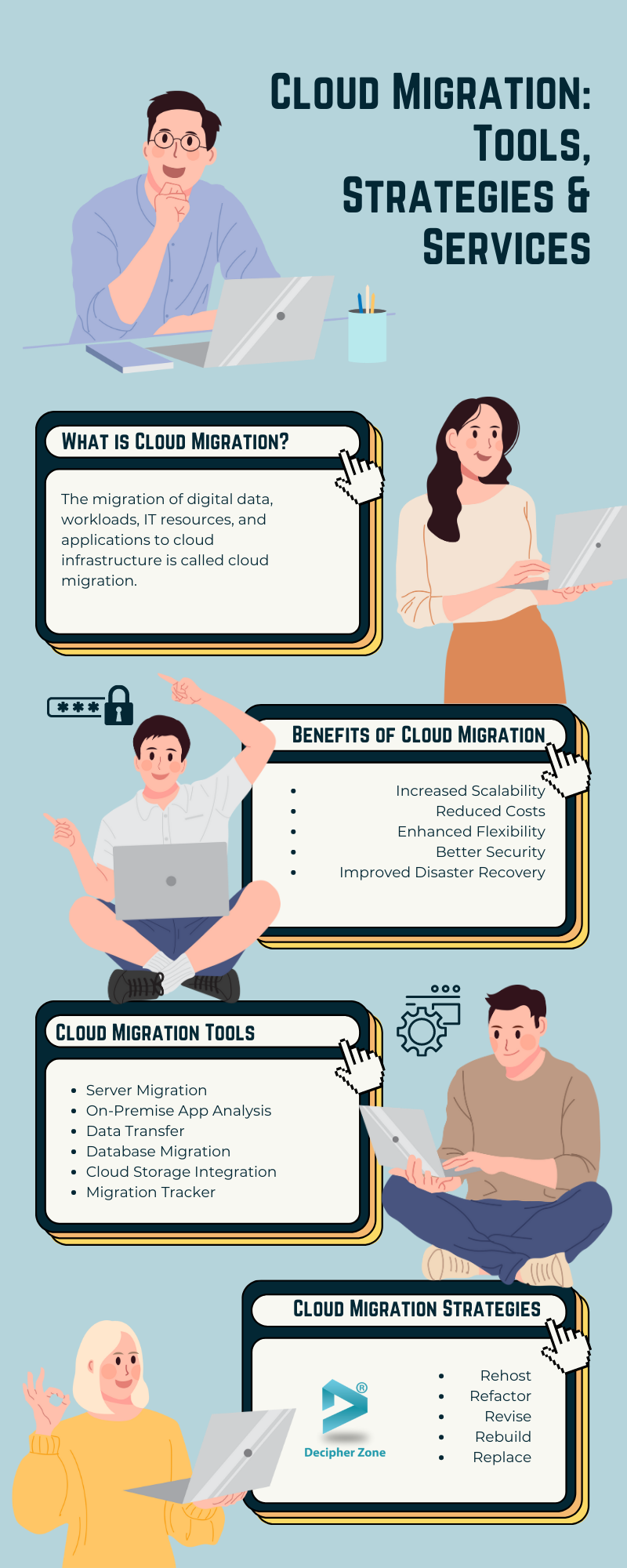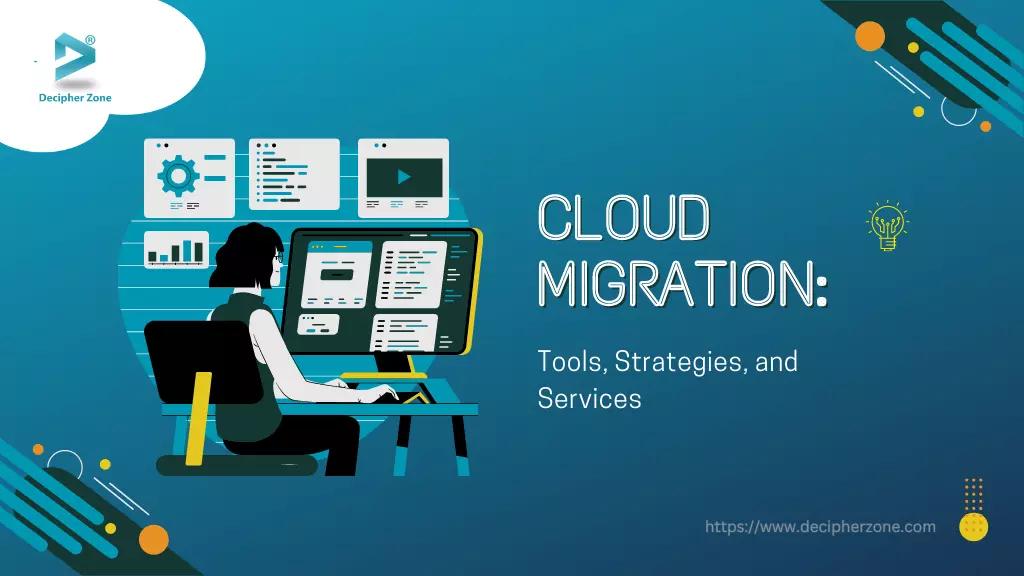Businesses used to rely on traditional on-premise servers for data storage or running their applications. However, maintaining and managing failing conventional servers can be costly and damaging to a business’s reputation.
In mitigating such risks, cloud technology can be the key. Although it sounds easy, migrating from local servers to the cloud can seem overwhelming.
And understanding cloud migration, its benefits, working, tools, services, and strategies will help you make the right decision for a smooth transition of your business applications to the cloud.
What is Cloud Migration?
The migration of digital data, workloads, IT resources, and applications to cloud infrastructure is called cloud migration. While some businesses might want to move these digital assets wholly, others might choose to partially migrate them.
Read: Cloud Application Development
Companies wishing to migrate from an inefficient and conventional infrastructure are now turning to the cloud to gain operational efficiencies, optimum performance, reduce costs, and other benefits of cloud technology. Cloud migration can involve more than one cloud.
Put simply, cloud migration involves moving from a physical server or data center to a virtual environment, which is hosted by a cloud services provider such as Amazon Web Services, Google Cloud, or Microsoft Azure. It is also necessary to plan, execute, and manage cloud migration carefully.
Benefits of Cloud Migration
Some of the major benefits that cloud migration can bring to a business are:
Read: Cloud Computing Benefit For Web App Development
Increased Scalability
Unlike on-premise infrastructures that require the setup and purchasing of physical servers, software licenses, and networking tools, using the cloud, businesses can scale large workloads and resources depending on the user’s requirements, allowing businesses to respond to changing business demands quickly.
Reduced Costs
The need to invest and maintain the IT infrastructure and operations is reduced by the cloud providers. Businesses migrating to cloud technology can invest more resources for innovation instead of that can be used for either improving existing services or creating a new one.
Enhanced Flexibility
Businesses, employees, and users can access the data, applications, or services from wherever they want. This flexibility makes it easier for businesses to expand into new markets, make the work more mobile, and provide services to the vast market.
Better Security
Cloud infrastructure offers a secure environment complying with regulatory standards and practices by leveraging security tools, best practices, policies, and tools. This in return leads to better data security.
Improved Disaster Recovery
In contrast to traditional backup and recovery methods, cloud computing offers businesses improved disaster recovery capabilities. Cloud service providers offer backup and recovery services that are more reliable and efficient, allowing businesses to recover more easily from disasters.
Understanding The Cloud Migration Process
Shifting your business to the cloud can be transformational, making it essential to prepare the required activities and capabilities to execute the cloud migration process effectively.
Read: Cloud Backup
You need to follow the below-mentioned steps to successfully migrate your business process into the cloud:
Define the requirements
Migrating to the cloud isn’t just a learning or practice exercise for some sort of new technology. So, before proceeding to the cloud migration, define the goals and objectives that you want to achieve through it.
Create a Security Strategy
Cloud migration also requires a strong cybersecurity approach to keep the resources, applications, and data protected from unauthorized access. You can implement a cloud firewall and other security measures to ensure cloud security.
Discovery and Assessment
Once you have identified the goals you want to achieve through cloud migration as well as developed a security strategy, scan and access the existing infrastructure, resources, data, and applications to determine what to move, when to move, and where to move.
Cloud Migration
Now comes the most crucial part - choosing the right cloud service providers where you will replicate previous databases throughout the cloud migration to keep data updated.
Also, for a smoother migration, you can take advantage of automated tools that will speed up the migration process while keeping quality and consistency intact.

Cloud Migration Tools and Services
Moving applications to the cloud significantly reduces the workload of a company. And some of the biggest cloud services providers like Google Cloud, Microsoft Azure, and AWS offer a multitude of cloud migration services.
Read: Google Cloud Tools for Application Development
So here is a list of different cloud migration services offered by these three gigantic companies.
-
Server Migration: Azure Migrate, AWS App2 Containers, CloudEndure Migration, VM migration, Migrate for Anthos, etc.
-
On-Premise App Analysis: AWS Migration Evaluator, Azure Migrate, AWS Application Discovery Service, etc.
-
Data Transfer Appliance: Data Box, Snow Family, etc.
-
Database Migration: Azure Database Migration Service or AWS Database Migration Services.
-
Cloud Storage Integration: StorSimple and Storage Gateway.
-
Migration Tracker: Azure Migrate and AWS Migration Hub.
Cloud Migration Strategies To Consider in 2023
The following are top 5 Cloud Migration Strategies To Consider in 2023
Read: Building Data Pipelines on Google Cloud Platform
Rehost
Also known as ‘lift and shift’ is a cloud migration strategy where the application is lifted from the local on-premise infrastructure and moved to a similar cloud infrastructure without making any architectural changes.
It is typically the first step for the majority of applications as it is easier to re-architect and optimize once they start working in the cloud environment.
Refactor
Unlike rehosting, refactoring cloud migration strategy involves re-architecting the application to make them ideal for the cloud infrastructure. This strategy is used by businesses that want to improve the application's performance, scalability, and agility.
Revise
To allow an application to leverage the cloud services, the revised cloud migration strategy requires rewriting or expanding the code base and making significant changes to its architecture.
Rebuild
This strategy involves changing the code base and architecture from scratch if the existing software doesn’t meet the new requirements of the business. While this strategy can be time-consuming and labor-intensive, it also allows businesses to leverage modern PaaS features.
Replace
It's also possible to discard and replace existing applications with SaaS (software-as-a-service) applications from third parties. Replace approach is used by a business that wants to use a prebuilt application instead of redeveloping its existing application.
How can Decipher Zone Help in Cloud Migration?
Undoubtedly, cloud technology is here to stay for a long time. And regardless of the size of your business, you should also consider cloud technologies to help smoothen business processes.
If you also want to build cloud-based software or move the pre-existing infrastructure to the cloud, our experienced team of developers can help you. So, what are you waiting for, get in touch with us Now!
FAQs About Cloud Migration
What is Cloud Migration?
The migration of digital data, workloads, IT resources, and applications to cloud infrastructure is called cloud migration.
What are the strategies for cloud migration?
The five main cloud migration strategies, include Rehost, Revise, Refacor, Replace, and Rebuild.
What are the benefits of cloud migration?
Some of the advantages that a business can gain from migrating to the cloud are reduced operational costs, better scalability, improved flexibility, enhanced security, and improved disaster recovery.

